NISSAN QUEST 2000 V41 / 2.G Manual PDF
Manufacturer: NISSAN, Model Year: 2000, Model line: QUEST, Model: NISSAN QUEST 2000 V41 / 2.GPages: 292, PDF Size: 2.48 MB
Page 71 of 292
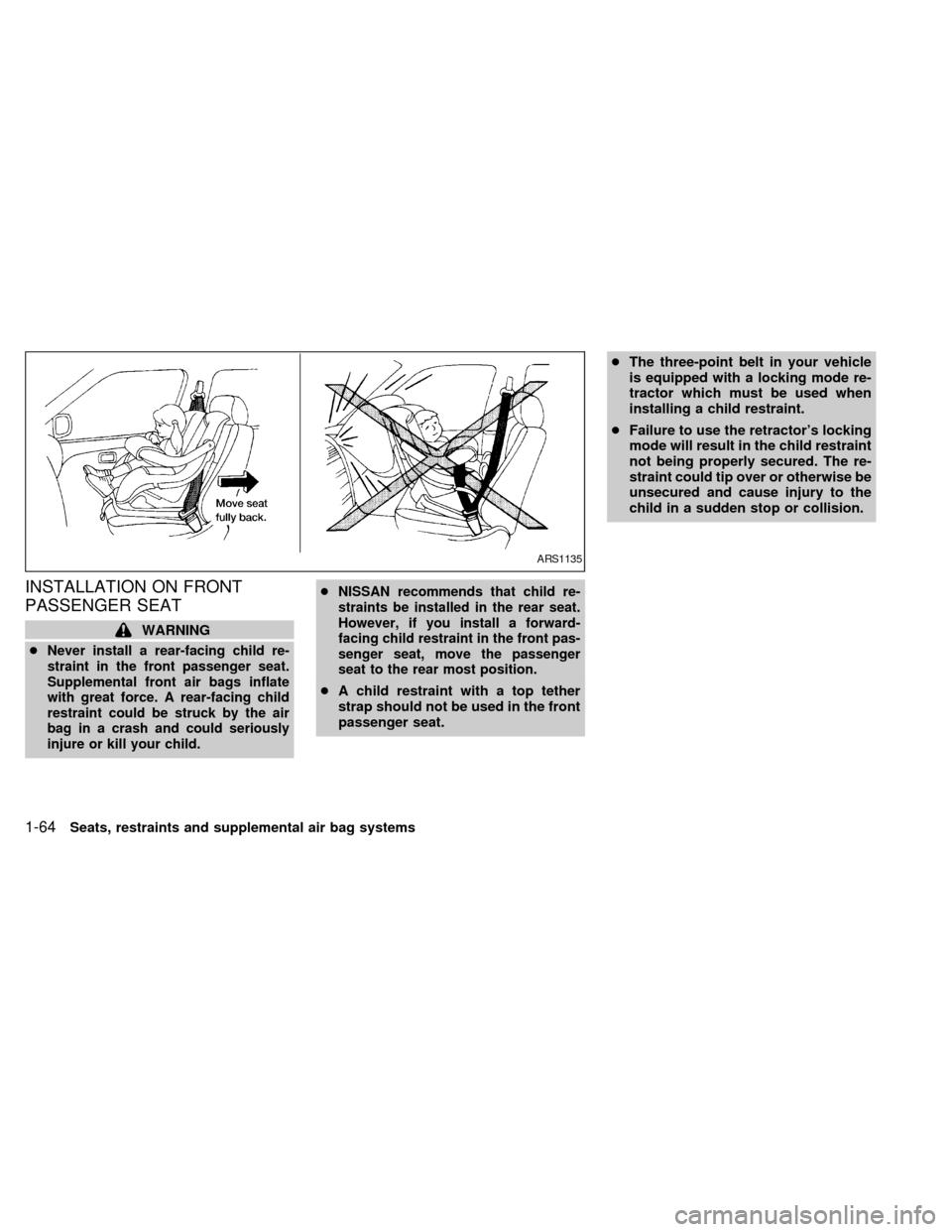
INSTALLATION ON FRONT
PASSENGER SEAT
WARNING
c
Never install a rear-facing child re-
straint in the front passenger seat.
Supplemental front air bags inflate
with great force. A rear-facing child
restraint could be struck by the air
bag in a crash and could seriously
injure or kill your child.cNISSAN recommends that child re-
straints be installed in the rear seat.
However, if you install a forward-
facing child restraint in the front pas-
senger seat, move the passenger
seat to the rear most position.
cA child restraint with a top tether
strap should not be used in the front
passenger seat.cThe three-point belt in your vehicle
is equipped with a locking mode re-
tractor which must be used when
installing a child restraint.
cFailure to use the retractor's locking
mode will result in the child restraint
not being properly secured. The re-
straint could tip over or otherwise be
unsecured and cause injury to the
child in a sudden stop or collision.
ARS1135
1-64Seats, restraints and supplemental air bag systems
ZX
Page 72 of 292

If you must install a child restraint in the front
seat, follow these steps:
1. Position the child restraint on the front
passenger seat.It should be placed in
a forward-facing direction only.Move
the seat to the rearmost position. Always
follow the child restraint manufacturer's
instructions.Child restraints for infants
must be used in the rear-facing direc-
tion and therefore must not be used in
the front seat.2. Route the seat belt tongue through the
child restraint and insert it into the buckle
until you hear and feel the latch engage.
Be sure to follow the child restraint manu-
facturer's instructions for belt routing.3. Pull on the shoulder belt until all of the
belt is fully extended. At this time, the
seat belt retractor is in the automatic
locking mode (child restraint mode). It
reverts back to emergency locking mode
when the seat belt is fully retracted.
ARS1163ARS1164ARS1165
Seats, restraints and supplemental air bag systems1-65
ZX
Page 73 of 292
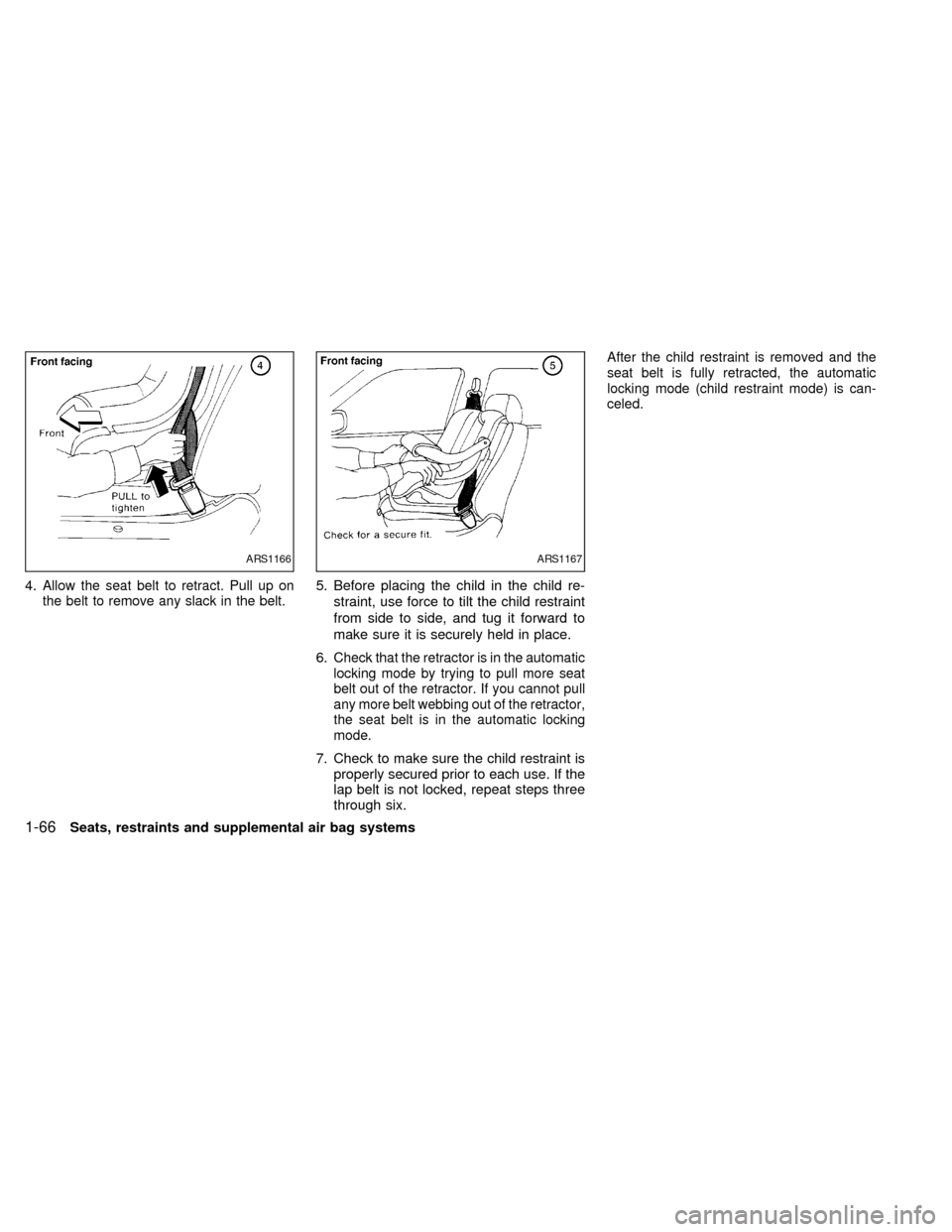
4.Allow the seat belt to retract. Pull up on
the belt to remove any slack in the belt.5. Before placing the child in the child re-
straint, use force to tilt the child restraint
from side to side, and tug it forward to
make sure it is securely held in place.
6.
Check that the retractor is in the automatic
locking mode by trying to pull more seat
belt out of the retractor. If you cannot pull
any more belt webbing out of the retractor,
the seat belt is in the automatic locking
mode.
7. Check to make sure the child restraint is
properly secured prior to each use. If the
lap belt is not locked, repeat steps three
through six.
After the child restraint is removed and the
seat belt is fully retracted, the automatic
locking mode (child restraint mode) is can-
celed.
ARS1166ARS1167
1-66Seats, restraints and supplemental air bag systems
ZX
Page 74 of 292
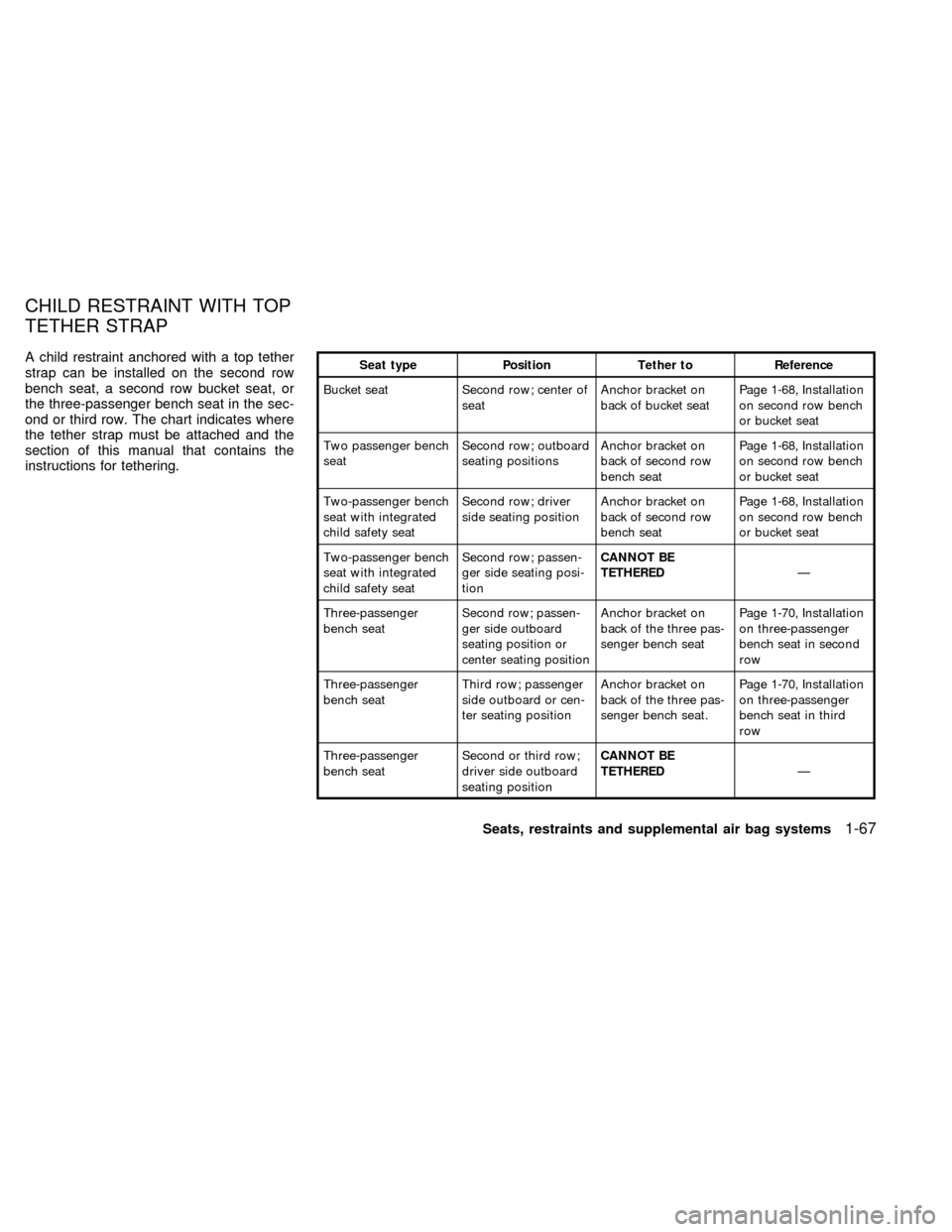
A child restraint anchored with a top tether
strap can be installed on the second row
bench seat, a second row bucket seat, or
the three-passenger bench seat in the sec-
ond or third row. The chart indicates where
the tether strap must be attached and the
section of this manual that contains the
instructions for tethering.Seat type Position Tether to Reference
Bucket seat Second row; center of
seatAnchor bracket on
back of bucket seatPage 1-68, Installation
on second row bench
or bucket seat
Two passenger bench
seatSecond row; outboard
seating positionsAnchor bracket on
back of second row
bench seatPage 1-68, Installation
on second row bench
or bucket seat
Two-passenger bench
seat with integrated
child safety seatSecond row; driver
side seating positionAnchor bracket on
back of second row
bench seatPage 1-68, Installation
on second row bench
or bucket seat
Two-passenger bench
seat with integrated
child safety seatSecond row; passen-
ger side seating posi-
tionCANNOT BE
TETHEREDÐ
Three-passenger
bench seat
Second row; passen-
ger side outboard
seating position or
center seating positionAnchor bracket on
back of the three pas-
senger bench seatPage 1-70, Installation
on three-passenger
bench seat in second
row
Three-passenger
bench seatThird row; passenger
side outboard or cen-
ter seating positionAnchor bracket on
back of the three pas-
senger bench seat.Page 1-70, Installation
on three-passenger
bench seat in third
row
Three-passenger
bench seatSecond or third row;
driver side outboard
seating positionCANNOT BE
TETHEREDÐ
CHILD RESTRAINT WITH TOP
TETHER STRAP
Seats, restraints and supplemental air bag systems1-67
ZX
Page 75 of 292

INSTALLATION ON SECOND
ROW BENCH OR BUCKET SEAT
A child restraint with a top tether strap may
be placed on the second row bench or
bucket seats. Once the child restraint is
properly secured to the seat (see ªInstalla-
tion on second and third row outboard posi-
tions, Front facingº earlier in this section),
follow the directions to attach the tether
strap to the tether strap anchor bracket.
To attach a tether strap to a second row
bench or bucket seat:
1. Route the tether strap under the head
restraint and between the head restraint
supports.cThe head restraint on the second row
bucket seat with the integrated child seat
is not adjustable, but there is an opening
under the head restraint to route the
tether strap through. Gently lift the head
restraint and route the tether strap under
the center of the head restraint through to
the back side of the seat.
APD0839
1-68Seats, restraints and supplemental air bag systems
ZX
Page 76 of 292
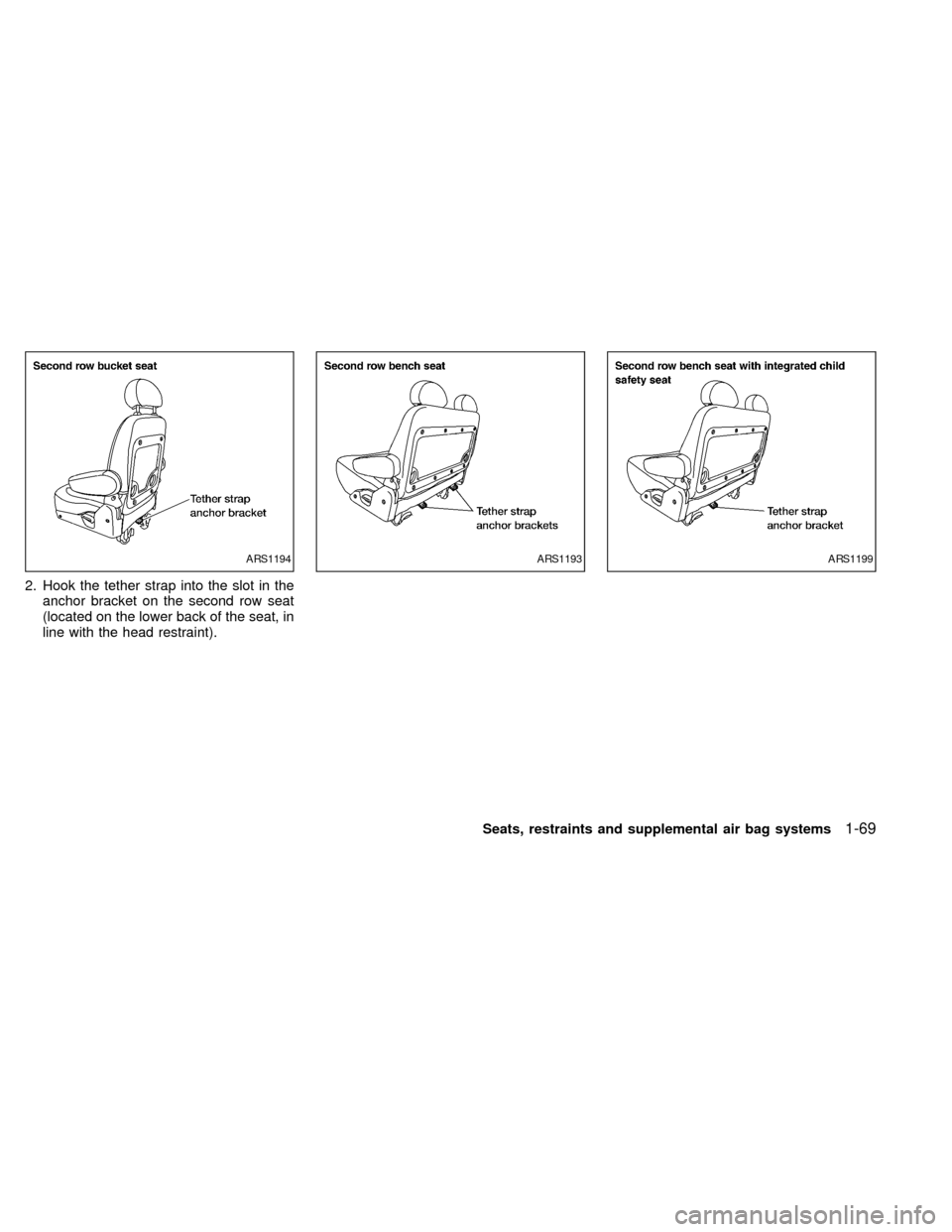
2. Hook the tether strap into the slot in the
anchor bracket on the second row seat
(located on the lower back of the seat, in
line with the head restraint).
ARS1194ARS1193ARS1199
Seats, restraints and supplemental air bag systems1-69
ZX
Page 77 of 292
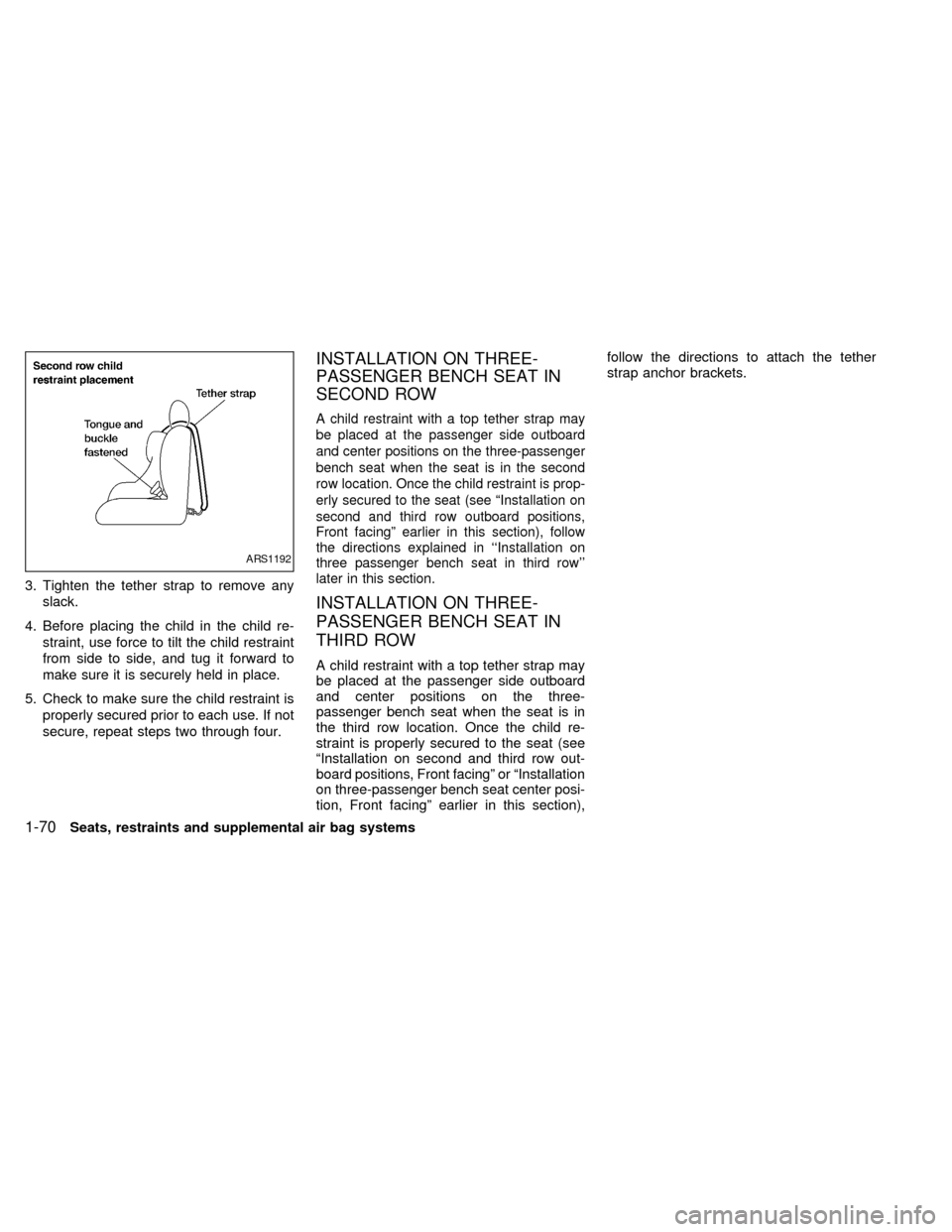
3. Tighten the tether strap to remove any
slack.
4. Before placing the child in the child re-
straint, use force to tilt the child restraint
from side to side, and tug it forward to
make sure it is securely held in place.
5. Check to make sure the child restraint is
properly secured prior to each use. If not
secure, repeat steps two through four.
INSTALLATION ON THREE-
PASSENGER BENCH SEAT IN
SECOND ROW
A child restraint with a top tether strap may
be placed at the passenger side outboard
and center positions on the three-passenger
bench seat when the seat is in the second
row location. Once the child restraint is prop-
erly secured to the seat (see ªInstallation on
second and third row outboard positions,
Front facingº earlier in this section), follow
the directions explained in ``Installation on
three passenger bench seat in third row''
later in this section.
INSTALLATION ON THREE-
PASSENGER BENCH SEAT IN
THIRD ROW
A child restraint with a top tether strap may
be placed at the passenger side outboard
and center positions on the three-
passenger bench seat when the seat is in
the third row location. Once the child re-
straint is properly secured to the seat (see
ªInstallation on second and third row out-
board positions, Front facingº or ªInstallation
on three-passenger bench seat center posi-
tion, Front facingº earlier in this section),follow the directions to attach the tether
strap anchor brackets.
ARS1192
1-70Seats, restraints and supplemental air bag systems
ZX
Page 78 of 292
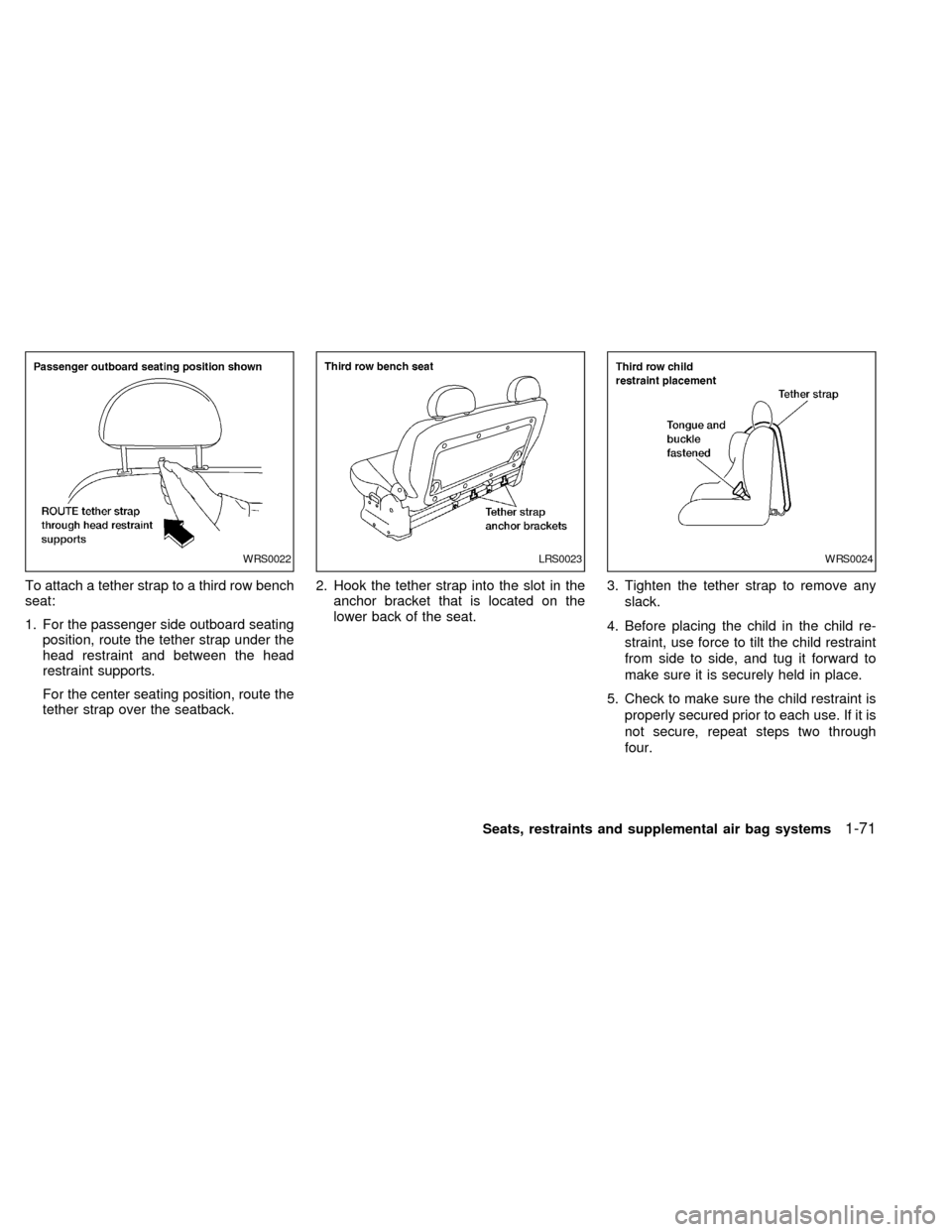
To attach a tether strap to a third row bench
seat:
1. For the passenger side outboard seating
position, route the tether strap under the
head restraint and between the head
restraint supports.
For the center seating position, route the
tether strap over the seatback.2. Hook the tether strap into the slot in the
anchor bracket that is located on the
lower back of the seat.3. Tighten the tether strap to remove any
slack.
4. Before placing the child in the child re-
straint, use force to tilt the child restraint
from side to side, and tug it forward to
make sure it is securely held in place.
5. Check to make sure the child restraint is
properly secured prior to each use. If it is
not secure, repeat steps two through
four.
WRS0022LRS0023WRS0024
Seats, restraints and supplemental air bag systems1-71
ZX
Page 79 of 292
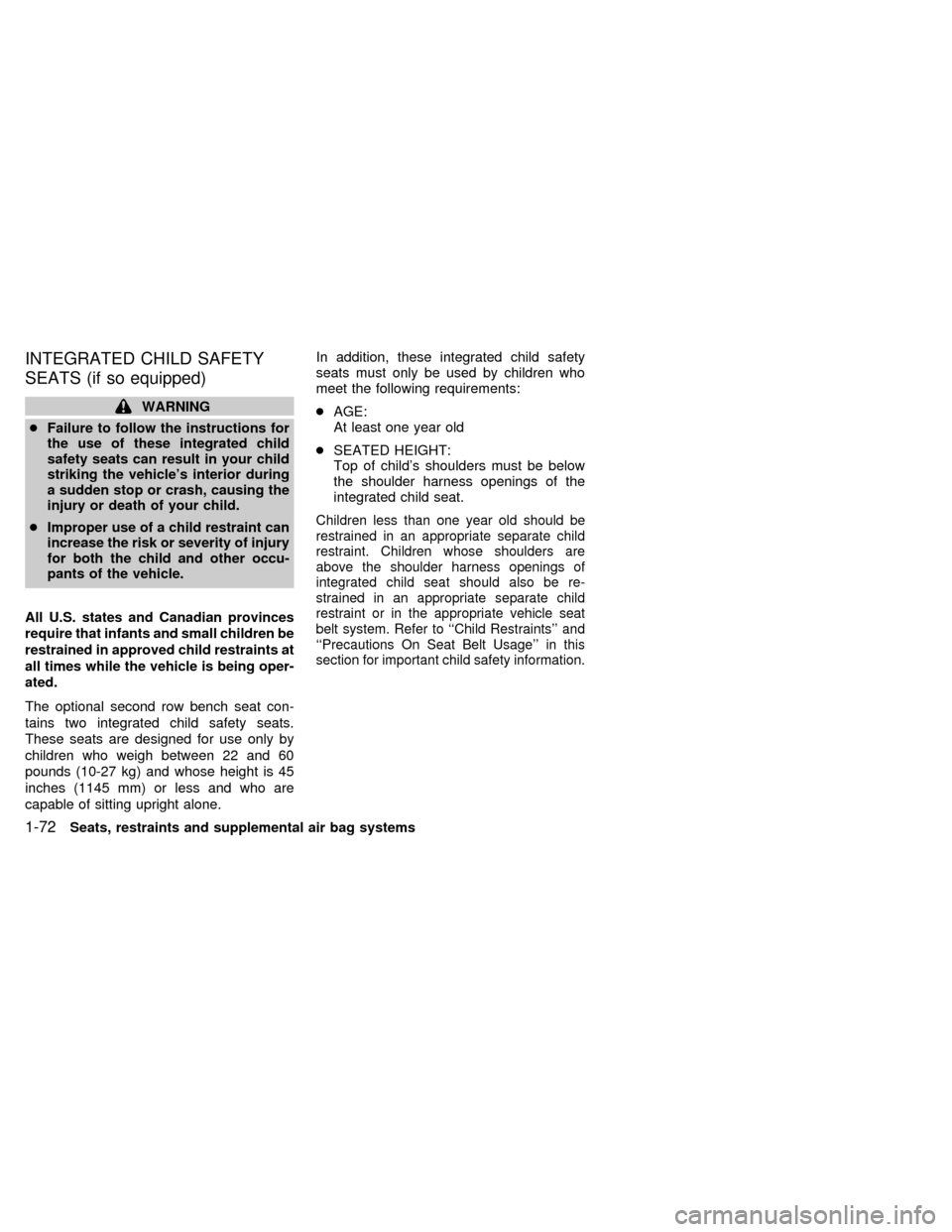
INTEGRATED CHILD SAFETY
SEATS (if so equipped)
WARNING
cFailure to follow the instructions for
the use of these integrated child
safety seats can result in your child
striking the vehicle's interior during
a sudden stop or crash, causing the
injury or death of your child.
cImproper use of a child restraint can
increase the risk or severity of injury
for both the child and other occu-
pants of the vehicle.
All U.S. states and Canadian provinces
require that infants and small children be
restrained in approved child restraints at
all times while the vehicle is being oper-
ated.
The optional second row bench seat con-
tains two integrated child safety seats.
These seats are designed for use only by
children who weigh between 22 and 60
pounds (10-27 kg) and whose height is 45
inches (1145 mm) or less and who are
capable of sitting upright alone.In addition, these integrated child safety
seats must only be used by children who
meet the following requirements:
cAGE:
At least one year old
cSEATED HEIGHT:
Top of child's shoulders must be below
the shoulder harness openings of the
integrated child seat.
Children less than one year old should be
restrained in an appropriate separate child
restraint. Children whose shoulders are
above the shoulder harness openings of
integrated child seat should also be re-
strained in an appropriate separate child
restraint or in the appropriate vehicle seat
belt system. Refer to ``Child Restraints'' and
``Precautions On Seat Belt Usage'' in this
section for important child safety information.
1-72Seats, restraints and supplemental air bag systems
ZX
Page 80 of 292
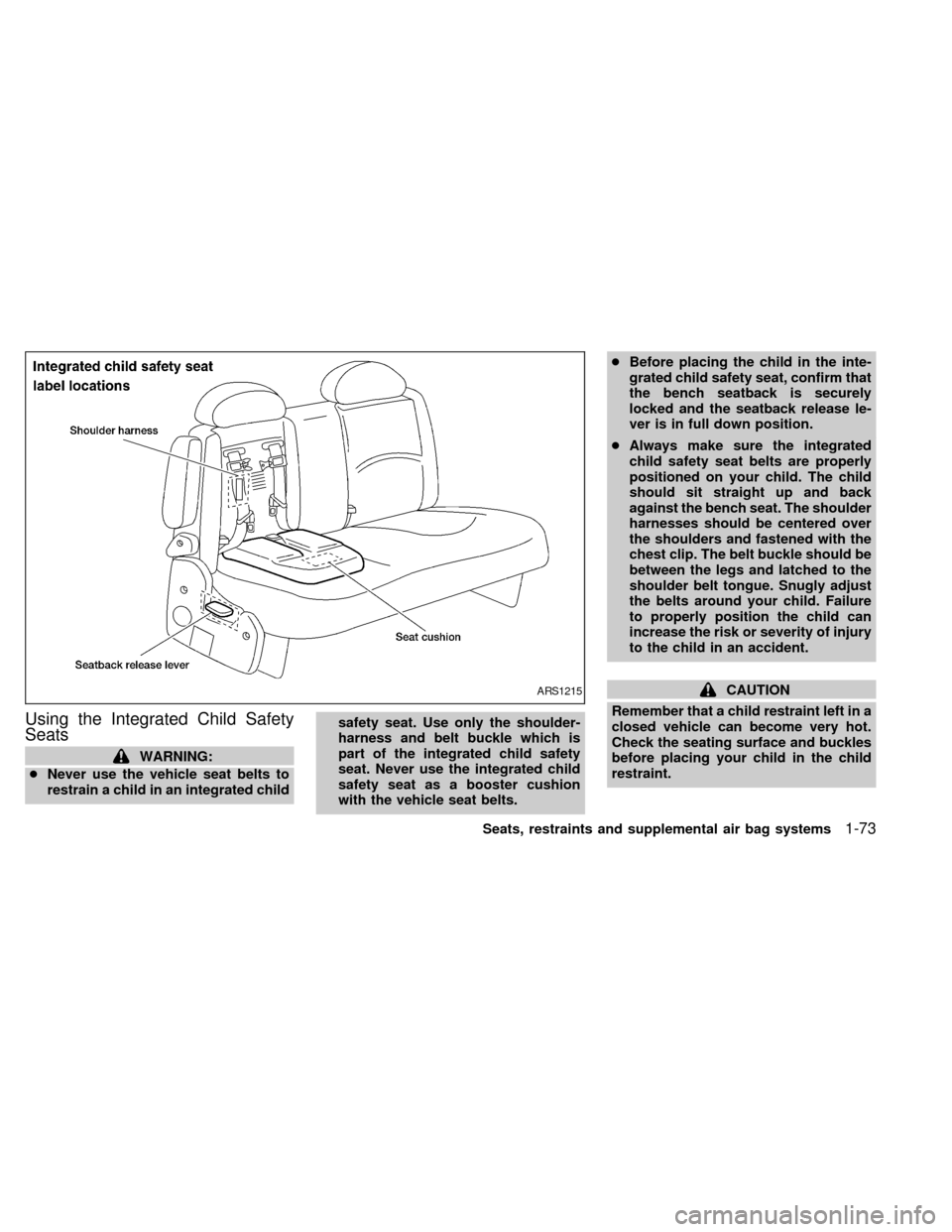
Using the Integrated Child Safety
Seats
WARNING:
cNever use the vehicle seat belts to
restrain a child in an integrated childsafety seat. Use only the shoulder-
harness and belt buckle which is
part of the integrated child safety
seat. Never use the integrated child
safety seat as a booster cushion
with the vehicle seat belts.cBefore placing the child in the inte-
grated child safety seat, confirm that
the bench seatback is securely
locked and the seatback release le-
ver is in full down position.
cAlways make sure the integrated
child safety seat belts are properly
positioned on your child. The child
should sit straight up and back
against the bench seat. The shoulder
harnesses should be centered over
the shoulders and fastened with the
chest clip. The belt buckle should be
between the legs and latched to the
shoulder belt tongue. Snugly adjust
the belts around your child. Failure
to properly position the child can
increase the risk or severity of injury
to the child in an accident.
CAUTION
Remember that a child restraint left in a
closed vehicle can become very hot.
Check the seating surface and buckles
before placing your child in the child
restraint.ARS1215
Seats, restraints and supplemental air bag systems1-73
ZX